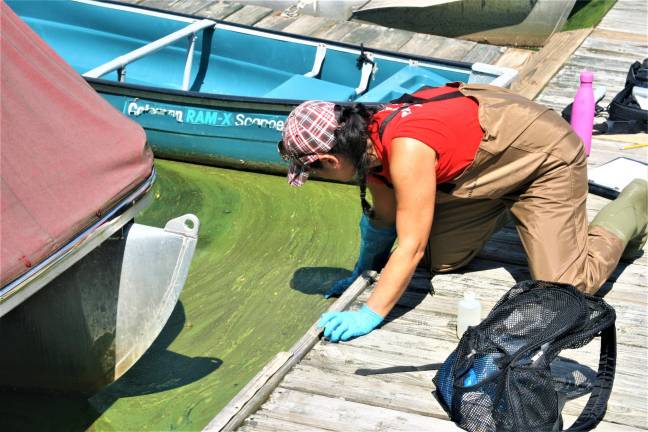While there is a New Jersey Department of Environmental Protection advisory in effect to not come in contact with the water on that state's side of Greenwood Lake, officials want to make it clear that the lake is open for business and recreation.
Local residents and business owners from both sides of the 7-mile bi-state lake packed a meeting of the Greenwodd Lake Commission at West Milford's town hall Wednesday night to get the latest information on a confirmed Harmful Algal Bloom advisory issued by the NJ DEP last week.

NJ DEP issued the advisory on July 16 after levels of cyanobacteria reached more than 20,000 cells per milliliter on the New Jersey side of the lake.
According to NJ DEP officials, amounts above that level could produce toxins that could cause a variety of symptoms for those coming in contact with the water or those that ingest it, depending on the sensitivity of the person.
NJ DEP representative Leslie McGeorge said the agency developed the criteria based on World Health Organization standards for exposure.
“(Levels of) 20,000-100,000 cells per milliliter are not normal,” she said. “This is an ecosystem out of balance.”
Similar to blooms on Lake Hopatcong, which were identified last month, the growth of the algae looks like spilled paint or “pea soup.”

Symptoms can run from a simple rash due to contact with the water to flu-like symptoms and vomiting if ingested, officials said.
A tale of two lakes
Greenwood Lake, the second largest body of freshwater in the state, is unique because it is shared by two states, New Jersey and New York, each with its own state environmental agency.
While McGeorge said that much of New Jersey's program regarding these algal blooms comes from how New York deals with them, New York relies more on visually identifying such blooms and then having people avoid them
New York Department of Environmental Conservation Representative Jackie Lendrum said New York does not necessarily take samples and measurements of blooms, but rather identifies them visually and then advises people to avoid the areas.
She said if a bloom can be visually identified, it's usually dense enough to have levels above 20,000 cells per milliliter.

New York does not have the same protocols as New Jersey regarding posting advisories or closing public swimming areas, like New Jersey did on its side last week.
Once the advisory was posted in New Jersey, three public beaches were closed to swimming and signs were placed in state-owned properties advising people to not contact the water.
The New York side of the lake, however, has no such postings or restrictions.
Frustrated businesses
A number of people at the three-hour meeting Wednesday were local business owners that depend on the summer months to earn a living, and expressed that frustration to not only officials, but to the media, including Straus News coverage of last week's advisory.
“(The Commission) has to get the message out that the lake is not closed,” one business owner said.
Many of the owners who spoke at the meeting said their respective businesses were down drastically since news of the advisory broke.
Commission Co-Chairman Paul Zarrillo said that activities, such as boating and fishing, are still allowed on both sides of the lake despite the advisory.
Greenwood Lake, New York Mayor Jesse Dwyer emphasized that swimming, as well as all other recreational lake activities are still permitted on that side.
In addition to getting word out that the lake is open, several people asked the NJ DEP to remove its signs on public land and to open up the swimming on the New Jersey side.
“I cannot lift an advisory that is based on science and facts,” NJ DEP Deputy Commissioner Deborah Mans said. “It would be irresponsible for the state to move forward with messaging that says it's safe to come in contact with the water from a public health perspective.”
Testing, testing
The Greenwood Lake Commission hired a group from Montclair State University to come and test the water at some 15 locations in both states on July 19.
Dr. Meiyin Wu reported that the group of five took samples from around the lake, at locations designated by the commission.
The testing looked for nine different components for an overall water quality of the lake, she said.
Some of those results were not yet available, but testing for cyanobacteria levels showed levels well above the 20,000 New Jersey limits at the locations, some levels reaching more than 1 million cells per milliliter.
Cyanobacteria grows in heat and sunlight, especially in nutrient-rich water with higher than normal phosphorus levels.
According to officials, recent incidents of heavy rains combined with high heat and humidity can make the algae grow.
One of the commission members said the New York locations for the testing, which cost the commission $8,700, were chosen because of their proximity to identified blooms.
The reasoning is to identify properties near the high concentrations that could be contributing to the blooms with the use of certain lawn chemicals or other storm water issues that could bring phosphorus and other nutrients into the lake.
The NJ DEP's McGeorge said the agency will continue to monitor the lake and would remove the swimming restrictions on the New Jersey public beaches once two consecutive samplings come back under the 20,000 limit.
